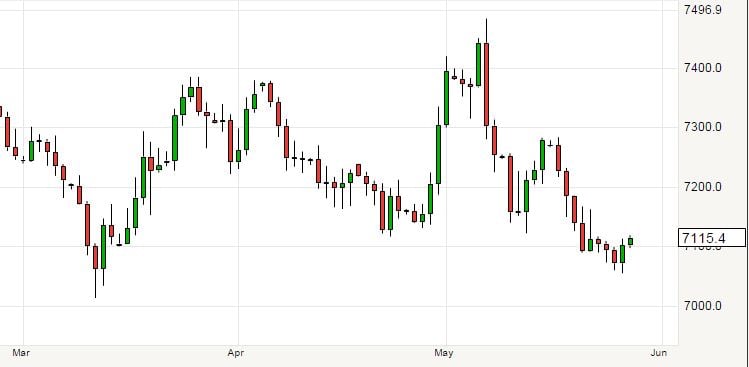EUR/GBP Exchange Rate Forecast to Begin Recovery on 12 Month Timeframe
Those holding euros and looking for a better exchange rate against the pound sterling will have to wait a while longer according to the latest research into the EUR complex conducted by Danske Bank.
The leading Scandinavian currency research house has told clients that the pound will continue to strengthen against the shared currency for some time to come. However, when we look ahead by a year the tide will have turned in the euro’s favour once again. At the very least it appears the incessany selling pressure will have run its course.
At the time of writing the euro to pound exchange rate (EUR-GBP) is quoted as being at 0.7117. The pound to euro exchange rate (GBP-EUR) is therefore at 1.4054. The below graphic confirms the euro remains near its 2015 lows against sterling:
Momentum Favours the British Pound… for Now at Least
The question, as always for those watching the currency markets, is where the euro is headed against the pound in the future. The answer to this question lies with the time-frame you are interested in.
According to Danske’s Morten Helt the short-term timeframe that will take us to the end of 2015 will favour the pound sterling. The longer-term picture that would see us to 12 months will be characterised by a turn-around in fortunes for the euro which should start gaining on the dollar, pound and other major currencies.
“In the short term, further liquidation of short EUR/USD positions might counter some of the EUR/GBP downside potential and we target EUR/GBP at 0.7300 in 1M. Looking further ahead, the combination of additional EUR weakness caused by the ECB’s ‘hot potato effect’ coupled with re-pricing of the BoE should keep EUR/GBP under pressure in the coming months and we target EUR/GBP at 0.69 in 6M,” says Helt.
On a six- to 12-month horizon, Danske expect EUR/GBP to stabilise and to eventually move higher as the Eurozone recovers and as Eurozone inflation is set to pick up significantly. This should cause EUR downside to fade and Danske target the cross at 0.71 in 12 months.
GBP to be supported by BoE and Interest Rates
The single most important factor behind the euro v pound sterling at the present time is the difference in interest rate policy at the Bank of England and European Central Bank. Where the ECB has opened the gates to pushing more money into the Eurozone economy the BoE is closing the gates. Interest rate rises over coming months is how the Bank will achieve its aim of tightening the flow of money in the economy.
As a general rule of thumb for those who don’t constantly watch the currency markets, keep in mind that when supply falls so prices (the exchange rate) must rise.
“We expect the MPC to hike in November this year. Although headline inflation is likely still to be low at this point, we think that the MPC members will judge that the medium-term inflation outlook calls for tighter monetary policy. It is important to remember that the low inflation is mainly due to falls in energy and food prices, which should begin to drop out at the end of this year. We still expect the BoE to increase interest rates at a very modest pace, taking the Bank Rate to 1.5% by the end of 2016. However, if we are right about the hike in Q4 15, BoE is still priced much too dovishly (first hike set for April 2016),” says Helt.
A Euro Recovery
Driving a return in strength for the euro exchange rate complex in about 12 months’ time will be a forecast pick-up in Eurozone economic activity and inflation.
“Once eurozone (headline) inflation starts edging up in H2, the re-pricing of the Fed has come to an end, and an eventual ECB QE exit moves to the fore, EUR/USD should start its journey towards the (higher) levels warranted by medium- to longer-term fundamentals. We still project the cross at 1.08 in 12M,” say Danske Bank.
We believe that any signs that the ECB are looking to exit its stimulus will not come anytime soon. Indeed, one Bank that is handling expectations over an exit from stimulus carefully is the Bank of England – communication has been consistent and very little is being given away with the aim being to keep the GBP cheap. The risks grow when the first interest rate rise is actually delivered as many in the market may not be expecting it.
It could well be a similar case for the ECB - they want the euro kept as low as possible for as long as possible and will contiue to maintain a dovish tone in coming months.
Draghi will be keen to emphasise the ECB’s commitment to the QE scheme, including its open-ended nature, and thus to do his best to dampen any discussion of the ECB starting to taper purchases prematurely.
“However, if we are correct that commodity prices and inflation rates in general are on the increase heading into H2, the price action over the past week should be regarded as an early warning that ‘reflation’ – and with it a possible ECB exit – will become important market themes as 2015 draws to a close,” says Danske’s Christin Tuxen.
When the BoE and US Fed start raising rates expect attention to swiftly turn to the ECB and speculation as to when the end of ECB will be announced. This is when those holding euros could well start pricing in a future of better exchange rates.





